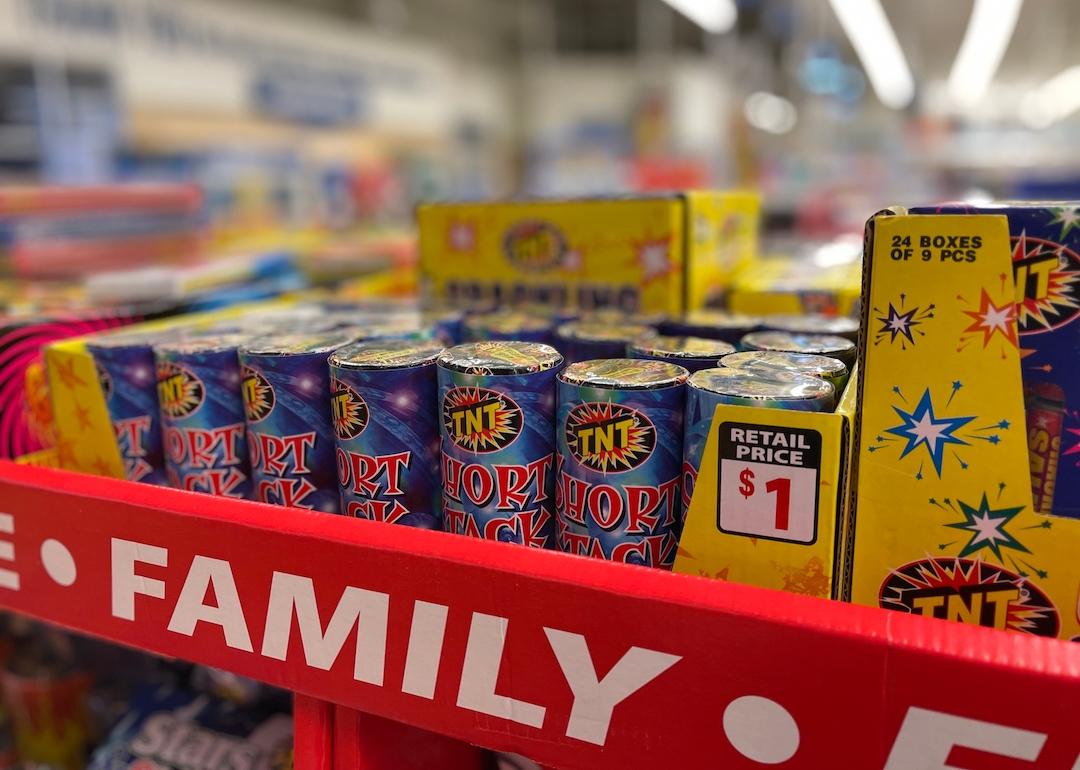
States spending the most on fireworks
Fireworks on the Fourth of July date back all the way to the nation's founding. On July 2, 1776, John Adams wrote to his wife that signing the Declaration of Independence—which would happen in two days—should be met with celebrations that included "illuminations," the 18th-century word for "fireworks." The pyrotechnic marvels have illuminated the skies since.
In the modern-day U.S., consumer fireworks are a $1.9 billion dollar business. Most of that consumption occurs right around the Fourth of July—and in all states but one (Massachusetts), some types of fireworks are legal to buy. Several states have additional restrictions on airborne fireworks, but allow sparklers and other, less powerful fireworks.
Americans' love of fireworks isn't limited to Independence Day, though: "Display fireworks," which are used in commercial displays rather than set off by consumers, amounted to $262 million in revenue in 2021. Even in states in which consumer fireworks are tightly regulated, fireworks shows still happen regularly at sporting events, festivals, and concerts.
States that tightly regulate fireworks have a solid rationale: exploding things can be dangerous. ValuePenguin reports a 538% spike in injuries on July 4 compared to the third. Even sparklers pose threats, as they reach extremely hot temperatures and cause burns to children every year. There are some key steps to keeping everyone safe: Don't let kids near the fireworks, keep cold water on hand, and don't go anywhere near any airborne fireworks after they've been lit; even if they appear to be dormant, throw water on them first just in case.
In celebration of fireworks going boom this Fourth of July, Stacker ranked the states spending the most on fireworks per resident with data drawn from imports to the state per capita based on data from the Trade Census and Census Intercensal estimates. Fireworks and population data were calculated from 2008 to 2021. Some states and regions without historical data available were dropped including Alaska, Washington D.C., Puerto Rico, Vermont, Delaware, Rhode Island and West Virginia.
States across the country saw a massive uptick in the number of fireworks being purchased and set off—often recklessly and illegally—during the pandemic, and total sales are only expected to grow. This list includes data through 2021.
The middle of the country outspent the coasts
States in the middle of the country like Missouri, Nebraska, Kansas, the Dakotas, Montana, and Wyoming—where the population density is the lowest—have higher per-person spending on fireworks. The more populous coastal regions spend less per person.
Disparities in spending are due to many factors, including rural populations having more space to set off private fireworks displays and fireworks being illegal in parts of California because of wildfire risks. Setting off a display requires a permit in Oregon, while Massachusetts has an outright ban on fireworks. Due to shipping costs and supply chain issues, overall costs for fireworks in 2022 are up 35% nationwide, which may impact sales.
Three states saw fireworks spending increase more than 5x since 2008
Nevada has seen its per-person fireworks spending increase by a factor of 13 since 2008. Georgia also saw a huge increase in per capita spending to coincide with the loosening of regulations. The state first allowed novelty fireworks such as sparklers to be sold in 2005, and in 2015 all consumer fireworks became legal to purchase.
Arizona in 2021 saw per capita fireworks spending increase to six times its 2008 spending levels. SB1275, which was signed into law in 2022, prohibits fireworks displays in Arizona between 11 p.m. and 8 a.m. – except on New Year's Eve and Independence Day.
Nationally, fireworks spending more than doubled since 2008
Despite predictions by some that light shows using drone technology would replace pyrotechnic displays, the market for fireworks has more than doubled in the past 14 years.
Demand substantially increased since 2020, when many municipalities canceled displays due to COVID-19. With continuing supply chain issues and the increasing cost of shipping containers across the Pacific, fireworks—nearly all of which are made in China—are retailing for about a third more than they did before the pandemic. In recent years fireworks regulations have become more relaxed and the vast majority of states now allow for the sale of fireworks.
South Dakota had some of the biggest increases in spending between 2020 and 2021
- Fireworks imported in 2020: $2.67 per person
- Fireworks imported in 2021: $10.87 per person
South Dakota Governor Kristi Noem in 2022 was denied a permit for a firework display at Mount Rushmore for the second year in a row. The National Parks Service cited Tribal opposition, wildfire risk and visitor service interruptions in its rejection.
The 2020 fireworks display at Mount Rushmore was the first display at the national park in 11 years. For 2022, residents will have to set off their own display or attend a municipal display.
Missouri spent more on fireworks than any other state
- Fireworks imported in 2020: $13.36 per person
Missouri, with a population of just over 6 million people, spends the most per capita on fireworks at $13.36 per person. Fireworks are legal to buy in Missouri between June 20 and July 10 and with the exception of the capital, they are legal to set off around Independence Day.
The Missouri Department of Public Safety issues around 1,500 permits to manufacturers and distributors of fireworks each year. People 14 year of age or older are able to buy fireworks in Missouri without a parent. The state fire marshall recommends that teens are closely monitored, everyone wear eye protection, and that all fireworks are launched from open spaces free of flammable debris.



